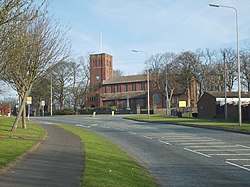Rowley Regis
| Rowley Regis | |
| Staffordshire | |
|---|---|
 St Giles Church, Rowley Regis | |
| Location | |
| Grid reference: | SO9687 |
| Location: | 52°28’48"N, 2°3’36"W |
| Data | |
| Post town: | Rowley Regis / Cradley Heath |
| Postcode: | B64, B65 |
| Dialling code: | 0121, 01384 |
| Local Government | |
| Council: | Sandwell |
| Parliamentary constituency: |
Halesowen and Rowley Regis |
Rowley Regis is a town in Staffordshire, within the Black Country and contiguous with the surrounding towns of the Black Country conurbation. It encompasses the wards of Blackheath, Cradley Heath and Old Hill, and Rowley Village.[1]
The village sits on Rowley Hill, which makes up part of the Rowley Hills famed for the quarrying of Rowley Rag Stone.
History
The recorded history of Rowley Regis begins in the 12th century,[2] when a small village grew around the parish church of St Giles, approximately two miles south-east of Dudley.
In 1913, suffragettes in Rowley Regis burnt the church down.
Rowley Regis began to develop as a town between the two World Wars, when thousands of privately owned and local authority houses were built in the surrounding area. During that time, Rowley Regis became a borough and incorporated the neighbouring communities of Blackheath, Old Hill and Cradley Heath, all places within the ancient parish of Rowley Regis, which despite being in Staffordshire was in the Diocese of Worcester. The parish contained the manors of Rowley Regis and Rowley Somery, the latter being part of the barony of Dudley, but the extents of these manors and the relationship between them are not clear.
Rowley Regis railway station was opened in 1867 in the south of the then village, and remains in use to this day.
Parish Church
St Giles Church stands on Church Road. It is not the first church for the parish but was designed by Holland WHobbiss and A S Dixon and built in 1923.[3]
The previous church, built in 1904, was burned down in 1913 by Suffragettes campaigning for the vote in a somewhat extreme way. Before the fury of women scorned destroyed the House of God, its predecessor had been destroyed by the hands of me; the previous church was built in 1840 but was found to be unsafe and condemned in 1900.
Outside links
| ("Wikimedia Commons" has material about Rowley Regis) |

References
- ↑ "About". I love Rowley Regis. rowleyregis.com. http://www.rowleyregis.com/about. Retrieved 9 October 2012.
- ↑ "Rowley Timeline". Rowley Village and Rowley Regis. http://rowleyvillage.webs.com/rowleytimeline.htm. Retrieved 9 October 2012.
- ↑ The Buildings of England: Worcestershire, Nikolaus Pevsner, 1963 p89